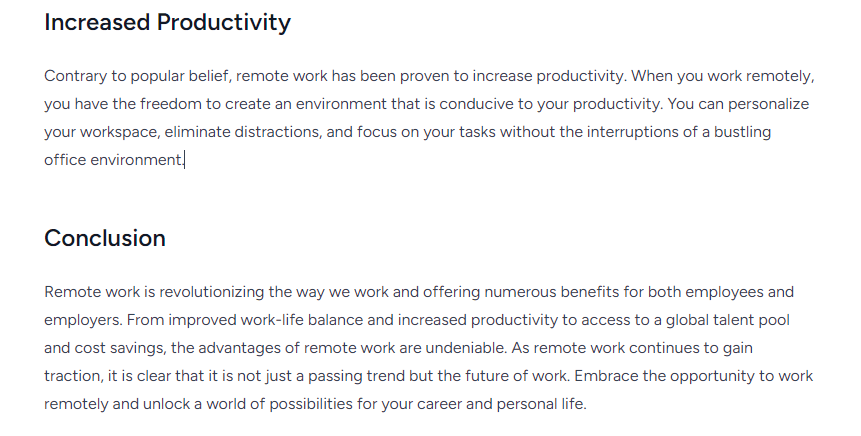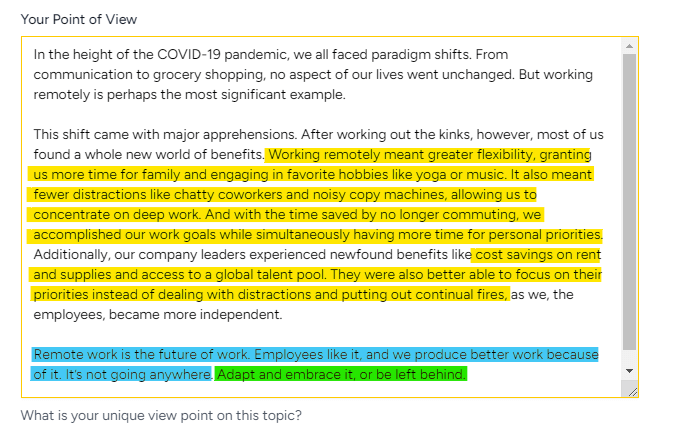Become a Master AI Prompt Writer: Crafting Your Point of View
When new technical and digital tools enter the marketplace, users rush to master them and find areas where they can add value (and perhaps earn money by doing so). We’ve seen it in social media influencing, eCommerce, SEO, and many other verticals. And now, with the influx of new AI generative writing tools cropping up, a new niche has emerged: the AI prompt writer.
What is AI prompting?
AI prompting is the process of providing instructions to an AI system to produce coherent and relevant responses, whether you’re generating written content, art, or something else.
Sometimes, you simply want to ask AI for information, like how many plays Shakespeare wrote or what year a historical event occurred. In these cases, it’s not all that important how you phrase your inquiry.
But if you want AI to produce an article or something that must be well-developed, engaging, and human-like, becoming a skilled AI prompt writer is essential.
Why is being a strong AI prompt writer important?
Effective AI prompt writing is crucial for making the most of AI generators. By providing clear and detailed instructions, you can guide the AI system to produce output that meets your unique requirements. Without effective prompt writing, the generated content may lack coherence, relevance, or adherence to the desired style — and it may sound generic.
For instance, a non-specific prompt like “Write an essay on marine life” could lead to anything, from the emotional life of dolphins to sustainable fishing.
It’s better to use prompts such as, “Write an essay about the life cycle of humpback whales, using active voice and incorporating the keyword phrase ‘humpback whale’s life cycle’ throughout the essay, including subheadings.” This detailed and specific prompt will likely result in content that closely aligns with your intended focus.
AI tools can produce a wide range of responses when given vague prompts. However, by becoming a proficient AI prompt writer, you can harness the full potential of these tools and create content that is tailored to your voice.
AI prompt writing in Quillbee
Quillbee takes AI prompt writing to the next level with its advanced capabilities. Unlike other AI content generators, Quillbee’s Content Brief feature allows you to provide detailed instructions and inputs, enabling the AI to generate content exactly as you envision.
The Content Brief encompasses various aspects, such as perspective pronouns, target keyword phrases, and tone, which enhance the AI prompt writing process — all of which play a pivotal role in humanizing the generated content. However, the Point of View section is the “secret sauce” behind Quillbee.
How to craft an effective Point of View
Point of View in Quillbee’s Content Brief focuses on your perspective, opinions, insights, and personal experiences, allowing you to infuse your voice into the AI-generated content.
When crafting your Point of View in Quillbee, keep the following tips and techniques in mind:
Length
Write between 200-300 words. This sweet spot gives Quillbee plenty of content to work its magic, but it’s concise enough that you’re not writing an entire article — which takes valuable time and defeats the purpose of AI content generation.
Opinions
Emphasize your personal beliefs and perspectives in the Point of View section. By clearly articulating what you believe to be true about the topic, you can add authenticity and credibility to your content. Sharing your opinions allows readers to connect with you on a deeper level and fosters meaningful engagement.
Perspective
Highlight the role of your unique experiences in shaping your perspective. Whether it’s personal anecdotes, stories, or reflections, incorporating these elements into your Point of View adds a human touch to the writing. Your perspective provides a valuable lens through which readers can understand the topic and its implications.
Insights
Utilize your relevant knowledge and expertise to provide valuable insights in the Point of View section. Leverage your understanding of the topic to offer analysis, commentary, and informed opinions. By sharing your insights, you position yourself as an authority and give readers confidence.
Call to action
Guide readers towards specific actions based on the presented topic and your Point of View. A well-placed call to action can encourage readers to engage further, share their thoughts, or take tangible steps. By providing a clear direction, you empower readers to make a difference and contribute to the conversation.
Format
Quillbee performs best when you organize your thoughts into a coherent beginning, middle, and end. These paragraphs should reflect your thesis (or introduction), the main points you want to discuss, and conclusion. When you lay out your POV this way, Quillbee better understands the logical path of your intended content. (If you’re unsure how to start, check out our article on bite-sized content creation strategy.)
Remember, you don’t need extensive technical knowledge to excel in AI prompt writing with Quillbee. The focus is on being yourself and leveraging your humanity to create impactful content.
An effective Point of View in action
See the value of being a proficient AI prompt writer in action with Quillbee. Using the Content Brief, we’re going to craft an article titled “Remote Work is the Future of Work.”
Sample 1: Generic prompt
Let’s prompt Quillbee with a fairly generic Point of View.

As you can see, the prompt is very short and lacks any personal opinions, perspectives, or insight. The main points (highlighted in yellow), are not explored. What are the supposed benefits for employees and companies? Also, the concluding statement (in blue), doesn’t adequately sum up why the reader should feel compelled or persuaded by the content. Lastly, the content is not organized into a distinct beginning, middle, and end.
Generic results
The generated article, as you might imagine, is equally generic. Here’s a snippet that includes one of the main points and the conclusion:

While this content is technically well-written, it’s not very compelling or engaging. There’s nothing original about it. The lack of a personalized Point of View means the generated article could be stock content that appears in any publication. Some readers may even be able to tell that it’s AI-generated.
Sample 2: Personalized prompt
Here’s an example of a prompt that includes the writer’s unique perspective, experience, and insights.

This prompt is well-organized with a clear introduction, section for key points, and conclusion with a call to action. The middle paragraph explores the benefits of remote work (in yellow). Meanwhile, the conclusion (blue) is hard-hitting, personal, and persuasive. It also includes a powerful call to action (green).
Compelling results
Using this personalized prompt, Quillbee generated a more humanized version of the article. See for yourself with this snippet from the final product:
Sample 1 was fairly stuffy. It keeps the reader at arm’s length. Sample 2, on the other hand, invites the reader in. It compels them to engage and think about the topic in relation to their own experiences. This is the power of a personalized and opinionated Point of View.
Become a master AI prompt writer with Quillbee
AI prompt writing is a valuable skill for generating coherent and relevant content using AI tools. Quillbee’s Content Brief, especially the Point of View section, enables you to infuse your humanity into AI-generated content.
By leveraging the power of Quillbee and becoming a masterful AI prompt writer, you can create content that captivates your audience, drives engagement, and achieves your desired outcomes.
Unlock your full creative power with Quillbee today.








